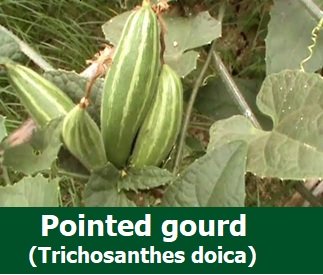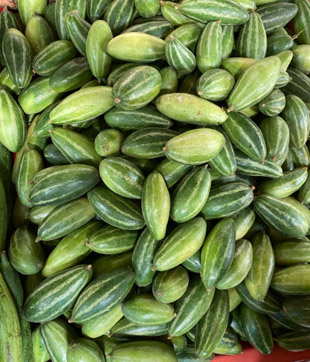Pointedgourd (Parwal) Nutrition facts
Pointed gourd, commonly known as Parwal, is a smooth, fusiform-shaped vegetable in the Cucurbit family and widely grown in the northern Indo-Gangetic plains of India. The immature fruits of Parwal are considered a delicacy in Punjab and fetch a premium price in the markets.
Family: Cucurbitaceae. Genus: Trichosanthes. Snake gourd (Trichosanthes cucumerina) is a close member of the genus
Scientific name: Trichosanthes doica.
 |
Varieties of cultivars grown, which vary in color, shape, size, and stripes on pods.
In India, parwal is another major crop cultivation done on the riverbed (diara land). It is suited to hot and humid regions, where rainfall is average. Well-drained, sandy, and loam soil, rich in organic matter is suitable for its growth.
Botany
This fast-growing perennial vine plant of the Cucurbitaceae family. Parwal is a dioecious climber with perennial rootstock. Crop duration is usually three years. Flowers are white and open during the early morning and close before sunset. The crop is highly cross-pollinated due to its dioecious nature.
Parwal gourd is mainly propagated through root suckers separated from old planting. Roots should be planted immediately after removal from the ratoon crop and planted at an angle of 30 to 40 degrees with 2 cuttings per pit. Stem cuttings of 60 cm long are also used for propagation.
Harvesting
Fruits are smooth, fusiform, 8 to 12 cm long, and seeded. Vines start fruiting 80-90 days after planting and plucking is done at weekly intervals. Fruits are invested at an immature stage when it is still green. Maximum yield is obtained during the rainy season till the end of October and November.
Health benefits of Pointed gourd (Parwal)
Pointed gourd is a very low-calorie Cucurbitaceae vegetable. 100 grams (3.5 oz) of raw fruit holds 20 calories, almost the same as for Ridge gourd (20 cal). Besides, it carries no saturated fats or cholesterol. Its peel is a good source of dietary fiber.
Parwal is a gluten-free food ingredient. It can be a good substitute for gluten-sensitive (celiac disease) persons.
Tender leaves and shoots of parwal are rich in flavonoids and β-carotene. The other flavonoid poly-phenolic antioxidants such as α-carotene, lutein, and zeaxanthin.
Together with vitamin A, these poly-phenolic pigment compounds help scavenge harmful oxygen-derived free radicals and reactive oxygen species (ROS) from the body that play a role in aging and various disease processes.
Pointed gourd fruit also has less sodium but contains good amounts of potassium, an important intra-cellular electrolyte. Potassium is a heart-friendly electrolyte that helps in decreasing blood pressure and heart rates by countering the pressing effects of sodium.
Further, parwal gourd carries modest levels of other B-complex groups of vitamins like pantothenic acid, riboflavin, and minerals like Calcium- 30 mg/100g, Phosphorus- 40 mg/100g, manganese, phosphorus, and zinc.
In Ayurvedic medicine, pointed gourd (parwal) is recognized as a diuretic, laxative, and cardiac tonic. It is also recommended for bronchitis, biliousness fever, and nervousness.
| Principle | Nutrient Value | Percent of RDA |
|---|---|---|
| Energy | 20 Kcal | 1% |
| Carbohydrates | 2.2 g | 1.7% |
| Protein | 2 g | 4% |
| Total Fat | 0.3 g | 1.5% |
| Cholesterol | 0 mg | 0% |
| Dietary Fiber | 3 g | 7% |
| Minerals | ||
| Calcium | 30 mg | 2.6% |
| Iron | 1.7 mg | 21% |
| Phosphorus | 40 mg | 5.5% |
| Phyto-nutrients | ||
| Carotene-β | 2.24 mg | -- |
Buying and storage
 |
| Pointed gourd in a grocery. |
Pointed gourd is available all around the seasons in India, Nepal, Pakistan, and Bangladesh. Choose fresh, green, immature, firm pods at the local farmer markets.
Avoid oversized, mature, tough-skinned, sunken, and flabby fruits as they may be a sign of old stock and flavorless. Also, avoid those with surface cuts, cracks, bruised, or broken.
Fresh Pointed gourd stores well if kept in the refrigerator. At home, store them in the vegetable compartment of the refrigerator, and should be used within two or three days of purchase before they begin to lose their luster.Preparation and serving methods
Wash in clean water to rid of any surface dirt and sand. Trim the ends. No need to scrape them. The skin of immature parwal gourd is edible. Slice/dice the pods as you want them in cooking using a paring knife. Like in other squashes and gourds, parwal gourd also should not be overcooked.
Pointed gourd has a mild, neutral flavor and soft-to-firm texture, similar to that of ivy gourd (kundru). It is used mainly in stuffed, stir-fried dishes and curries/soups. It complements particularly well with lentils in lentil curry and mixed-vegetable stews.
Here are some serving tips:
In Northern India, Pakistan, and Nepal, the pointed gourd is popularly called parwal (परवल). It is employed in stuffed sabzi (Bharwa parwal), stews, and curries.
Sliced/diced pointed gourd is employed in tasty masala stir-fries in many parts of North Indian states and served with roti/rice.
In Bihar and Bengal, aloo-parwal ki sabzi (Potato-Pointed gourd stew recipe) is a popular subsistence food served with steamed rice.
T. doica tender leafy tips and tendrils are equally popular and used as greens/potherb in dishes.
In Bihar, the pointed gourd is known by the local name Patal/patol (parwal). Immature, green pods are used in the preparation of mouth-watering pickles.
Peeled, slit, and deseeded parwal is stuffed with cheese, sugar, and pistachio mix and enjoyed as a sweet side-dish (parwal ki burfi).
Safety profile
Pointed gourd (parwal) consumption rarely elicits allergic reactions.
Oftentimes, a few parwal pods (T. doica) can be bitter due to terpenoid toxic compounds such as cucurbitacin B, D, G, H,, etc.
If found, discard the whole fruit. In a case of discomfort after consumption (nausea, vomiting, diarrhea, or any feeling of uneasiness), one should seek immediate medical attention. (Medical disclaimer).
Also read ≻≻
≺≺ Sanke gourd (Chichinda) nutrition facts.
≺≺ ivy gourd (kundru) nutrition facts.
≺≺ Tinda gourd nutrition facts.
≺≺ Bottle gourd nutrition facts.
≺≺ Back to Vegetables from Pointed gourd (Parwal). Visit here for an impressive list of vegetables with complete illustrations of their nutrition facts and health benefits.
≺≺ Back to Home page.
Further reading:
Gopalan et al. 1989 table 1- Nutritional values of Indian Foods.
Pointed gourd.-PDF